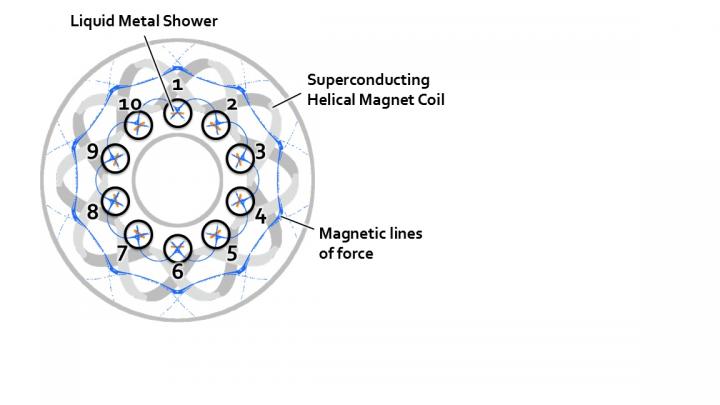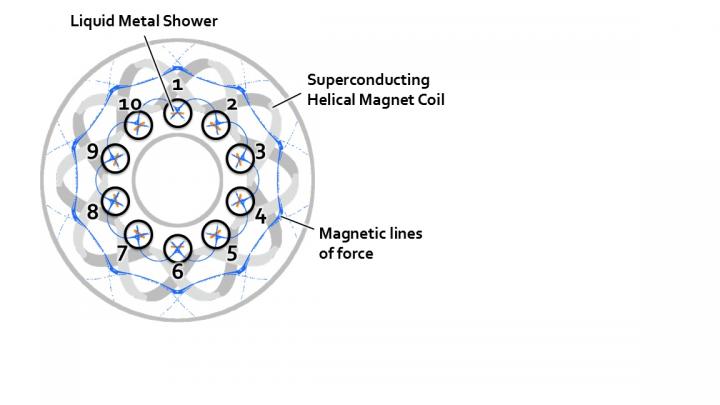
Credit: Dr. Junichi Miyazawa
In a magnetic field confinement fusion reactor, we maintain the high-temperature plasma through the magnetic field lines by floating the plasma apart from a vessel. However, there forms inevitably a location where the plasma hits. In such a place, in order to receive the heat from the plasma a heat absorption device called the divertor is mounted. In current plasma experimental devices, including the Large Helical Device (LHD) at the National Institute for Fusion Science (NIFS), a solid divertor is typically used, where the plasma is guided to a plate or block composed of carbon or tungsten and those plates or blocks are cooled by water. In the International Thermonuclear Experimental Reactor (ITER), too, a solid divertor composed of tungsten blocks that will be cooled by water is being adopted.
The solid divertor, because it suffers wear from being struck by high temperature plasmas, requires frequent maintenance. At NIFS, the helical-type fusion reactor, for which design research is being advanced, has the special characteristic of good prospects for steady operation. Conversely, because the structure is three-dimensional and complicated, how divertor maintenance will be undertaken is becoming a difficult technological issue.
In the future fusion reactor, the quantity of heat that the divertor will receive will grow larger, and there is concern that the heat flux will surpass the ITER design value substantially, which is approximately 20 megawatts per one square meter. As a divertor that will bear this extremely high heat flux, methods using liquid metal have been proposed and considered for more than 40 years. The idea has been to receive the high heat flux with the flow of melted lithium, tin, and other liquid metals. If the flow velocity can exceed several meters per second, then the divertor can withstand the fusion plasma's high heat flux. On the other hand, because particles that have been converted into neutral gas from a plasma stop on the divertor, the role of exhausting those gases to the outside is thus demanded. In particular, regarding the helical-type fusion reactor with its complicated structure, there had been no suggestion of the idea of a liquid metal divertor where high heat resistance and evacuation performance are compatible.
The research group of Professor Junichi Miyazawa, Professor Akio Sagara, and others, all of the National Institute for Fusion Science, constructed a new type of liquid metal shower divertor system that evacuates plasma as neutral gases before arriving at the vessel. They aimed a fine jet stream of liquid metal lined up in a shower condition at peripheral areas of the high-temperature plasma. They utilized tin, which is excellent for low vapor pressure and for being inexpensive, and also for safety.
In this new method, they placed the apparatus at intervals in just ten places inside the toroidal confinement device (see Figure 1). In this way, maintenance becomes much easier to perform. Conversely, the area which the plasma may contact decreases, and then the heat load is greatly increased. If we utilize high-speed liquid metal flow, then this will become a countermeasure.
Because high-temperature plasma moves along the magnetic field lines, in placing the liquid metal at a slant, a strong wall is formed through which the plasma cannot pass. (See Figure 2 to the left.) The plasma neutralized on the surface of the liquid metal shower passes through the interstices of the shower toward the rear face, and thus effective evacuation is possible. (See Figure 2 to the right.)
The liquid metal shower can bear an extremely large heat load that exceeds by approximately ten times the value tolerated by the recent ITER divertor. Even with such a high heat load, we have learned that if we use a liquid metal flow of 4 meters per second then the high heat load can be easily blocked. As shown in Figure 3, because there is the important characteristic in which when plasma touches the shower one time, it does not strike the vessel.
In the liquid metal shower divertor, a stable flow over a length of a few meters is necessary. The flow is accelerated by gravity, and when the diameter becomes thin the surface simultaneously becomes unstable, drips fall, and spray is generated. As a device that receives heat, this is not desirable. In order to suppress the speed by the gravity, we inserted an object that would become resistance against the flow inside the liquid. In the internal resistance, we use wire and tape, or a chain. Which is best will vary depending upon the variety of the fluid and the desired flow speed. When there is internal resistance, because the high temperature area and the low temperature area will easily become agitated, we also anticipate the effect which lowers the highest temperature and suppresses the evaporation of the liquid metal.
In this new procedure, compared to procedures utilized to date which used carbon and other solids, together with heat-resistant performance growing by more than 10 times, it may be anticipated that high evacuation performance will also be achieved. Further, there are no restrictions against device longevity from wear caused by plasma, and device maintenance becomes easy. Because the helical fusion reactor has a complicated three-dimensional structure, it is believed that using liquid metal in the heat-receiving device will be problematic. But according to this research, it has been indicated that this will be possible.
These research results were presented at the 26th International Atomic Energy Agency conference held October 17-22 in Kyoto, Japan.
Regarding the divertor that is expected to bear the extreme high heat load in the fusion reactor, there had not yet been an answer. This research will provide a breakthrough regarding this difficult problem, and will be an important step toward achieving the future fusion reactor.
Regarding this research, we have developed a technology for stabilizing a flow that exceeds several meters. (The patent application is currently under review.) The liquid flow, such as drinking water that flows from taps and fire truck water, is a conventional phenomenon. But in the ways of using liquid flow many possibilities are hidden. In particular, in a stable and long flow of liquid, from the fields of agriculture and chemistry to the fields based on our lives such as the humidifier and interior decorations, there are a wide variety of applications. Even as a topic of academic research, water is captivating. If attention is drawn to the utility of liquid flow by this research, we may anticipate further activities in related research fields.
###
Media Contact
Dr. Junichi Miyazawa
[email protected]
81-572-582-159
http://www.nins.jp/english/
############
Story Source: Materials provided by Scienmag





